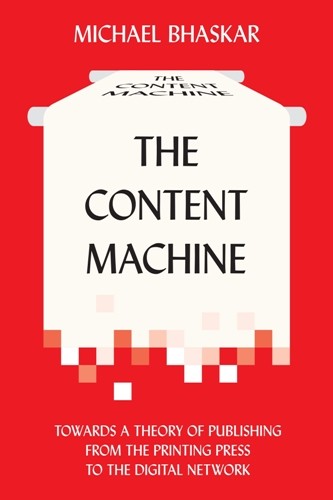 The following is an interview with Michael Bhaskar, author of The Content Machine: Towards a Theory of Publishing from the Printing Press to the Digital Network.
The following is an interview with Michael Bhaskar, author of The Content Machine: Towards a Theory of Publishing from the Printing Press to the Digital Network.
This book is a ground-breaking study that demonstrates how publishing can survive and thrive in the digital age.
Q: As the title of your book suggests, you are in favour of finding a ‘Theory of Publishing’. Why do you think a theory of publishing is necessary and why do we need it now?
Michael Bhaskar: Despite employing millions of people around the world, it’s not clear what publishing actually is or means. When you look at the different kinds of publishing, different definitions, different histories, it doesn’t add up. It conflicts. So we need a better explanation, especially in today’s world, when anyone can be a publisher. What makes you a publisher in the first place? Also, there is plenty of literary, communications and media theory, but no publishing theory. Again, that doesn’t make sense as publishing is a critical part of literature, communication and media.
Q: ‘[P]ublishing is in crisis’. In your opinion, what is the greatest threat to the publishing industry as it exists today?
MB: The biggest threat to publishing is disintermediation – the cutting of publishers out of the value chain. This threat has been made much more serious by the Internet. It’s the nature of the network that many of the structural features of a publisher can be bypassed. We need to reinvent, and better understand the role if publishers are going to have a future. Publishing itself won’t go away; publishing is an essential activity in society. Publishers as they exist today, however, might.
Q: It has been mentioned again and again that the publishing industry is old-fashioned and therefore lagging behind in the modern world. In what way do you think it is necessary for publishing industry to adapt to a more modern standard?
Firstly, I think this is a myth. When you examine contemporary publishers they are much more sophisticated than people often give them credit for. When you look at publishers historically, they have actually been on the cutting edge of a host of developments, from advanced technology to new business practices. Publishers have lead the way for hundreds of years. That said, the nature of the digital challenge and disintermediation in particular, does mean there have to be huge changes.
The main thing is recognising that the core of what a publisher does has evolved. It used to be about making content available. Now it is about making markets and audiences for that content. In both cases I argue publishing is about amplification. It’s just that amplification means something different in the context of abundance created by the Internet. Marketing is the first thing. The next thing I would say is that publishers need more direct relationships, a ‘lean’ methodology that builds learning into their workflows and a greater range of products.
Q: Why would you recommend students read your book and how do they gain most from doing so?
My book aims to fuse the practical and the theoretical, the historical with the future oriented. Most books on publishing shy away from the big, deep questions. In today’s world, because of publishing’s great existential challenge, that no longer works. We all – students, academics, practitioners – have to get a better handle on the nature of publishing to ensure it stays vibrant, diverse and high quality. It’s an immense challenge and one the book, I hope, helps with in a way no one else has tried.
Find out more about the book and the author on our website:
http://www.anthempress.com/the-content-machine
You can follow Michael on Twitter @michaelbhaskar
www.michaelbhaskar.com/
